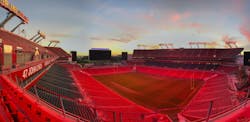Super Bowl LV ushers in new approach to LED sports venue lighting
The Tampa Bay Sports Authority and upstart Sportsbeams Lighting have partnered to deliver enhanced LED-based lighting of Raymond James Stadium and the playing surface with the installation to be on a global stage Feb. 7 with the playing of Super Bowl LV. The individual Sportsbeams luminaires integrate white LEDs to light the playing surface and RGB+A (red, green, blue + amber) LEDs to deliver dynamic effects. Sportsbeams says that the installation can deliver 2 million color options.
Super Bowls have previously been associated with major advancements in solid-state lighting (SSL) for sports fields. Back in 2015, we covered the lighting of University of Phoenix Stadium by then-Ephesus Lighting before the Feb. 1, 2015 game. Subsequently, Ephesus was acquired by Cooper Lighting (Eaton at the time).
In the case of the Tampa stadium, the new SSL system has been functioning throughout this entire National Football League (NFL) season. Of course, the NFL aggressively tries to control every element of publicity surrounding the league, and an announcement about the lighting has not been made until now. We could not even find any reference to the new lighting from other Tampa-area news outlets such as TV stations from earlier in the 2020‒2021 season.
Sportsbeams is new to the application and it brings the aforementioned new approach. We will get to the color capabilities in a moment, but the new approach starts at a more fundamental level in luminaire design. Most early sports-venue lighting offerings from companies such as Musco utilized small arrays or groups of LEDs placed under a total internal reflection (TIR) optic that controlled the beam pattern. Such luminaires might have had a dozen or more of these individual LED clusters. More recently, increases in LED output have allowed designs to move to one LED per optic and more tightly packed arrays similar to what is seen in street lights. The Sportsbeams products have a single large array of LEDs all placed in a reflector and behind a glass secondary optic. You can see the architecture in the nearby video.
There are reasons that either approach might be superior. We covered a Musco project a few years back lighting Petco Park, the home of the San Diego Padres Major League Baseball (MLB) team. At the time, a Padres executive told us that by controlling each individual LED cluster in the ballpark, the SSL system could create a spotlight that tracked a relief pitcher from the bullpen to the mound. You could also think of a case where perhaps baseball needs more vertical illumination for fielders to track fly balls, whereas a sport like soccer is played closer to the ground. Granularity of control could enable such customization.
The Sportsbeams platform only offers control at the individual luminaire level. But the reflector and lens combination provides very uniform light over a beam pattern in the 20‒50° range. Different models and ordering patterns reflect beam pattern. The result is excellent horizontal and vertical illumination within the specified beam.
Moreover, the design and installation of such a system is far simpler than one where individual luminaires must be precisely placed to meet the lighting standards of various sports leagues. We wrote a couple of times about Signify using a light measurement robot to help automate the alignment of sports-venue LED lighting.
The reflector and lens design is also critical for the color capabilities of the Sportsbeams system. The company hasn’t detailed exactly the mix of LEDs that it uses, but we’d presume that a majority are white LEDs for field illumination. But the design still affords excellent color mixing when the control system is set to bathe all or part of a stadium in colors. There is just a limit as to how granular the color control can be.
Sportsbeams has been pretty secretive about its control scheme for the luminaires. There is nothing posted about it on the company website. We learned that the company is using 5G wireless to connect the central management system and the luminaires. And then a DMX control system is used to dim/brighten or change colors at the individual luminaire level.
The company has designed custom drivers for its products. Each luminaire includes a mount for a driver just above or below at the base of the reflector. The company further offers the option of installing four drivers for every three luminaires in a configuration that it calls RAID (redundant array of independent drivers). If one fails, the spare takes over and the system remains fully operational. Heard a similar story before? Yes, it sounds like IT system RAID (redundant array of inexpensive disks) that protects against disk drive failure and Sportsbeams probably should have come up with a different name, because there may well be an IT RAID system connected to the LED central management system that communicates with the RAID driver configuration.
The Sportsbeams approach does raise the question of thermal mitigation. It packs a large number of very-high-power LEDs on a relatively small printed-circuit board (PCB). The company engineers developed a three-level thermal system to ensure reliability. The system includes heat pipes to pull heat from the PCB substrate combined with active fans and thermal fins to help dissipate the heat.
The world will get to see the technology on display on Sunday, although be forewarned that the NFL will have brought its own custom lighting in for the one game as well. So it could be tough to discern the source of what you see on TV.
“We are very proud to be the first stadium in the world to utilize this advanced Chromabeams technology. This stadium improvement, combined with the many premium upgrades over the last few years to Raymond James Stadium, provide fans an enhanced event experience,” said Tampa Sports Authority president and CEO Eric Hart. “These continued improvements will position Raymond James Stadium to host future world-class events, as evidenced by us hosting Super Bowl 55 on February 7, 2021.”
Still, remember that while it was energy efficiency that first led sports facilities to LED technology, it has been light quality for local fans and HDTV viewers that has driven adoption in many cases for professional venues. “The sporting world has never seen lighting like this,” commented Russ Schroader, vice president of sales and marketing at Sportsbeams. “Athletes will surely love the lack of glare and unbelievable visual acuity, while fans enjoy an awe-inspiring show that will elevate live performances and events.”
For up-to-the-minute LED and SSL updates, why not follow us on Twitter? You’ll find curated content and commentary, as well as information on industry events, webcasts, and surveys on our LinkedIn Company Page and our Facebook page.

Maury Wright | Editor in Chief
Maury Wright is an electronics engineer turned technology journalist, who has focused specifically on the LED & Lighting industry for the past decade. Wright first wrote for LEDs Magazine as a contractor in 2010, and took over as Editor-in-Chief in 2012. He has broad experience in technology areas ranging from microprocessors to digital media to wireless networks that he gained over 30 years in the trade press. Wright has experience running global editorial operations, such as during his tenure as worldwide editorial director of EDN Magazine, and has been instrumental in launching publication websites going back to the earliest days of the Internet. Wright has won numerous industry awards, including multiple ASBPE national awards for B2B journalism excellence, and has received finalist recognition for LEDs Magazine in the FOLIO Eddie Awards. He received a BS in electrical engineering from Auburn University.





